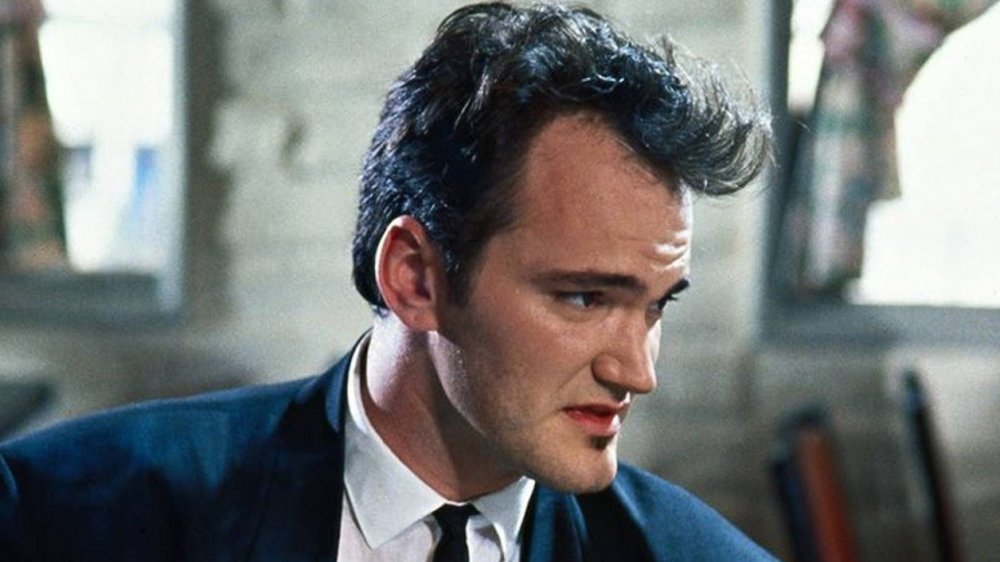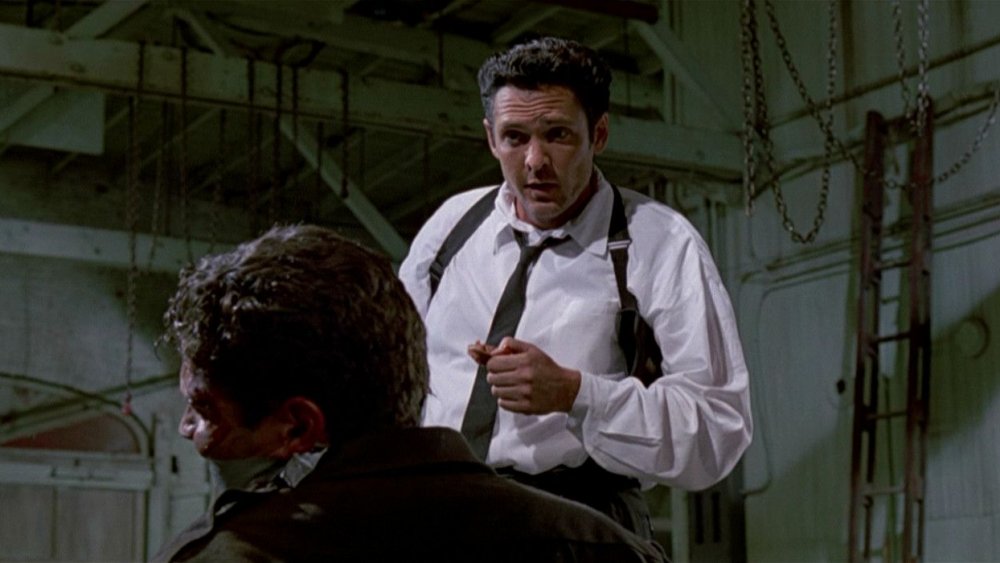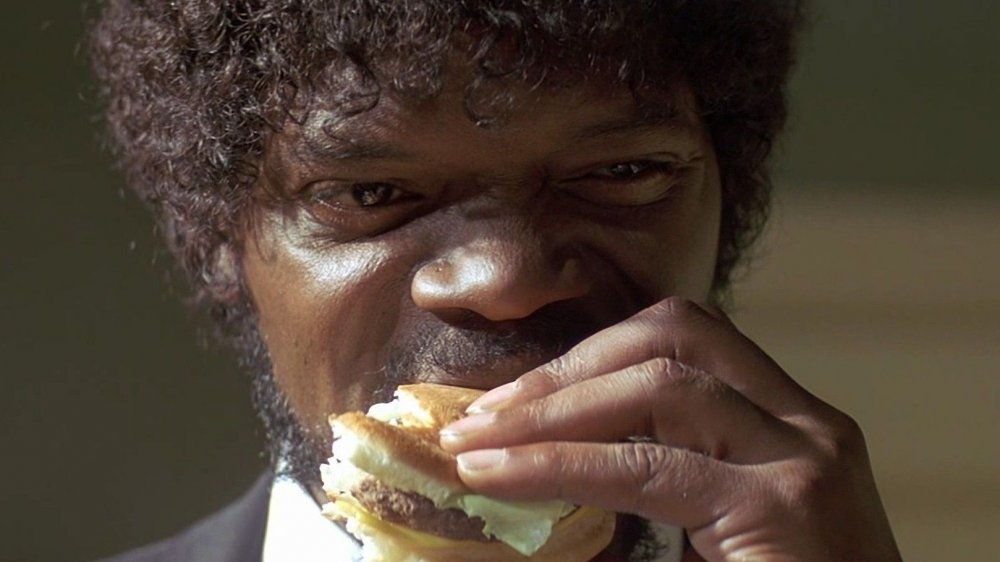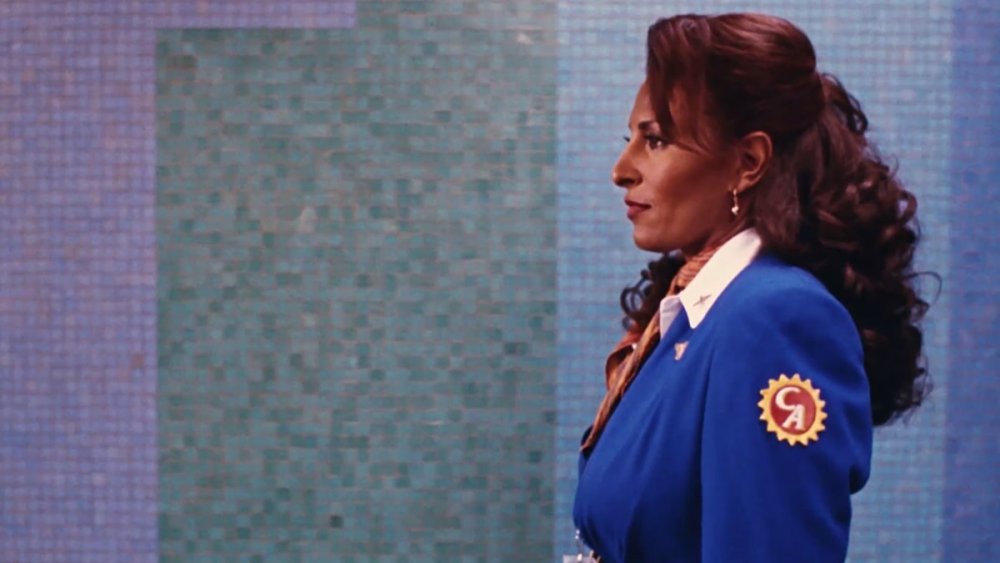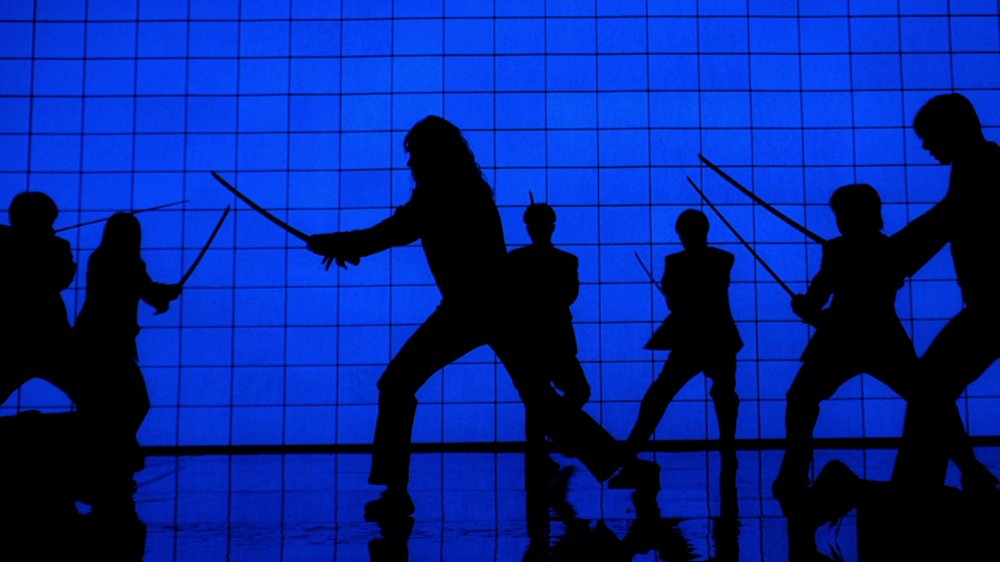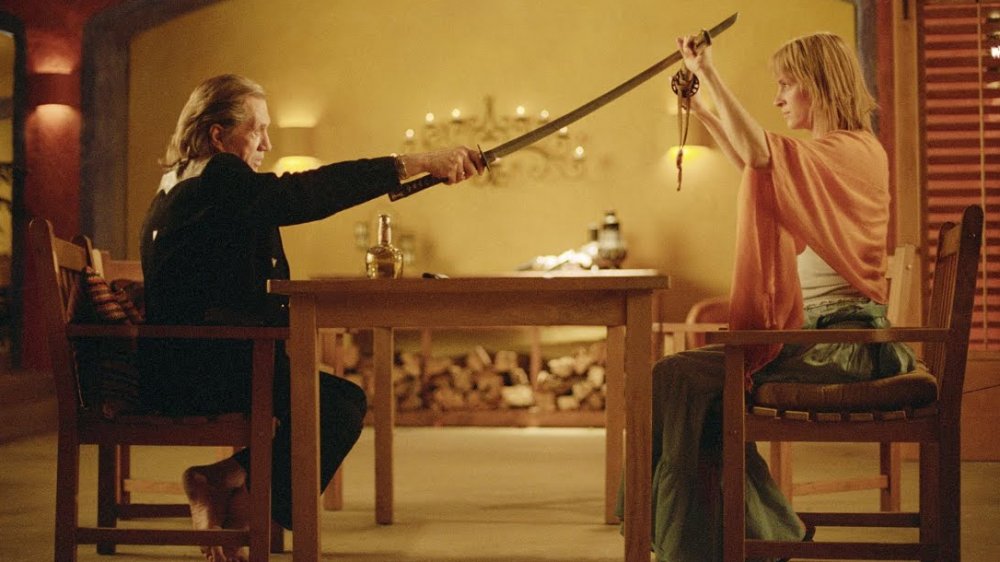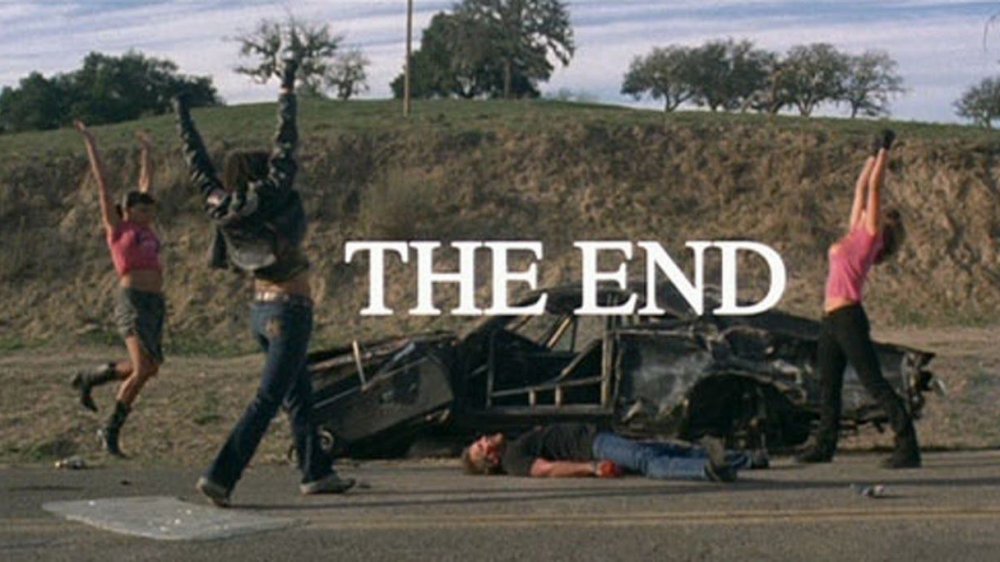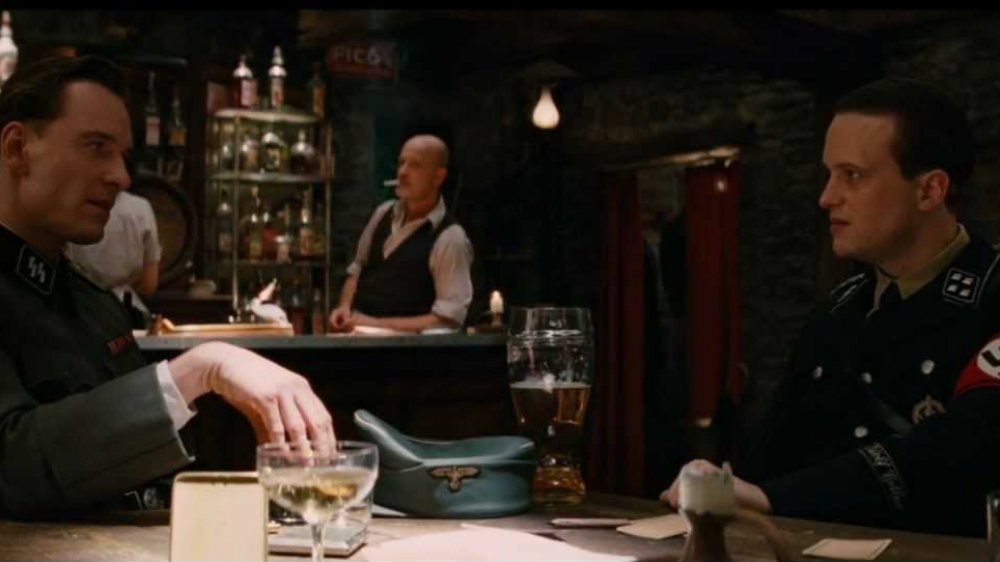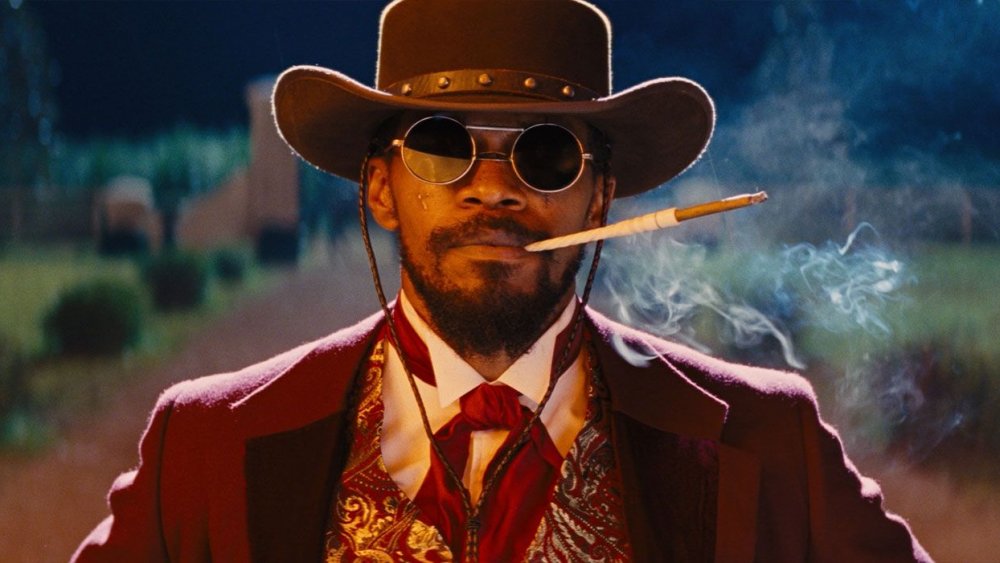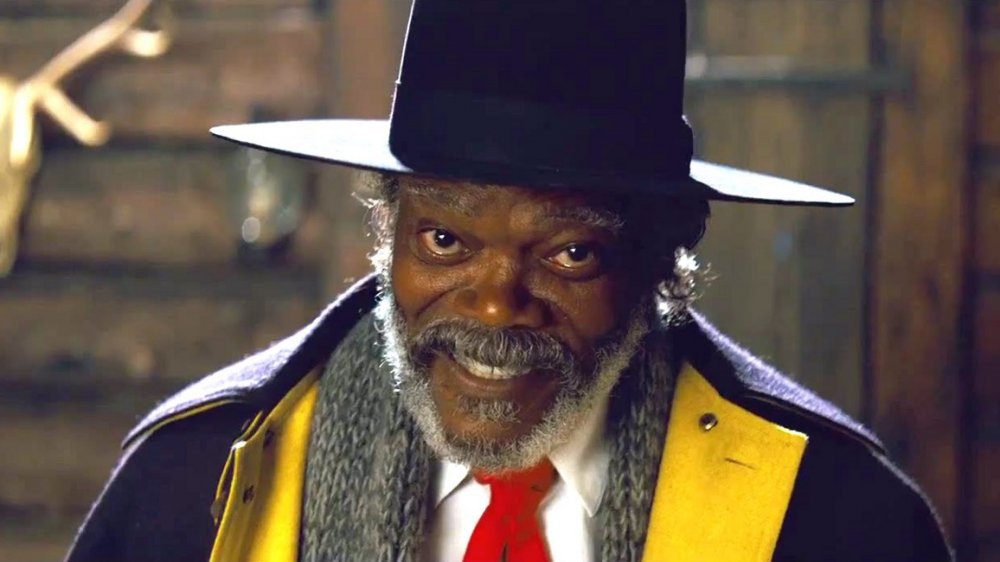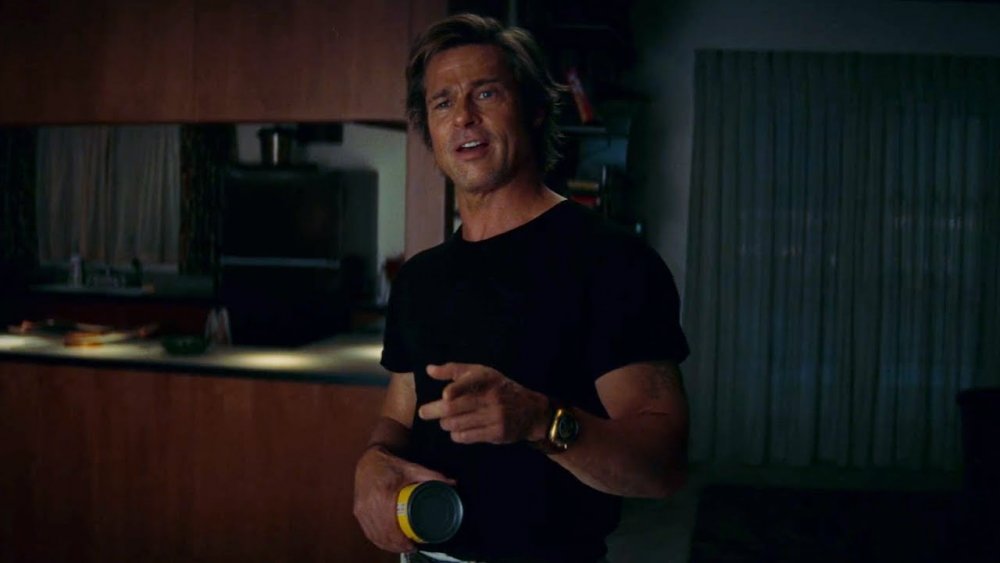The Most Iconic Scene From Every Quentin Tarantino Movie
Over the course of one of the most celebrated careers in Hollywood, auteur Quentin Tarantino has crafted some of the greatest films ever made. Known for his razor-sharp dialogue, larger-than-life characters, shocking violence, and plotlines that never fail to twist and turn, all of his films tend to deliver an unforgettable viewing experience.
Every time Tarantino directs or works on a film, you can recognize his efforts. There's something uniquely Tarantino-y about the way the camera moves, the actors speak, and the scene plays out. Let's put it this way — if someone's making a quip in the middle of a Mexican standoff that doesn't turn out the way anyone expects, you can bet that Tarantino was behind the camera.
As a result, Tarantino's films are packed with moments so memorable that they're downright iconic. To that end, let's take a look at the most iconic moments from each of his movies. Keep in mind that we're focusing solely on his directorial efforts, so the gems he penned like True Romance and Natural Born Killers will have to wait for another time.
(Be warned — major spoilers below.)
Reservoir Dogs - Stuck in the middle with you
With Quentin Tarantino's first film, Reservoir Dogs, audiences were introduced to his distinctive blend of humor and violence. Opening with a discussion on the finer points of tipping your waitress before eventually closing with a disastrous Mexican standoff, it gave us a healthy taste of what we could expect from the director's movies to come.
Reservoir Dogs tells the tale of a group of jewel thieves with questionable allegiances and the undercover cop trying to bring them down. Packed from beginning to end with smart dialogue and an innovative storytelling structure, it's a wild ride that will keep you guessing about who will come out on top right up until the final shot.
While Reservoir Dogs is packed with great moments, it's hard to argue that any one scene stands out more than when Mr. Blonde (played with creepy perfection by Michael Madsen) tortures a captured police officer by cutting off his ear with a razor and douses him with gasoline, intending to set him on fire, all the while dancing around to "Stuck in the Middle with You" by Stealers Wheel. It's a horrifying, absurd moment that practically has you watching through your fingers, and it's one of the most representative scenes in the Tarantino oeuvre.
Pulp Fiction - Great vengeance and furious anger
Tarantino's second film brought him to a wider audience and garnered near-universal praise. Released in 1994, Pulp Fiction wove together several seemingly random plotlines revolving around various criminal activities that usually go dangerously (if somewhat hilariously) wrong. With its star-studded cast delivering outstanding performances across the board throughout a unique narrative boasting some of the most engaging scenes ever captured on film, it's not hard to see why the movie earned a slew of Oscar noms, as well as one win for Best Screenplay.
When it comes to designating a single scene as "most iconic," it's a genuinely difficult task as Pulp Fiction is playing with a stacked deck. Is it when Vincent and Mia dance the twist at Jack Rabbit Slim's, or maybe later when he plunges a needle into her overdosing heart? Could it be Christopher Walken's monologue about sticking a watch where the sun don't shine? Or when Butch saves Marsellus from from the sadistic Zed? These are great scenes one and all, but for our money, we have to go with Jules' initial delivery of his Biblical vengeance speech.
Early in the movie when hitmen Jules and Vincent go to exact revenge upon a group of low-level criminals who've ripped off their boss, the former — in a performance that might be a career high for the great Samuel L. Jackson — delivers his immortal Ezekiel speech before opening fire. With its sly humor, high-volume fury, and unexpected shifts in tone and outcome, it's not only one of the most memorable scenes from Tarantino's wider body of work but in all of cinematic history.
Jackie Brown - Across 110th Street
Released in 1997 and based on Elmore Leonard's novel Rum Punch, Jackie Brown primarily tells the story of the titular character's attempt to escape trouble with the law and violence at the hands of the suspicious gun-smuggler she works for. Around this, we watch as a bail bondsman falls in love with Jackie and attempts to help while the smuggler's less-than-brilliant partner in crime fumbles his way through the situation.
After the in-your-face nature of Pulp Fiction, this movie was far more subtle in tone, carrying itself upon highly believable performances and a complex crime plot as opposed to big moments the way most Tarantino films do. But that doesn't mean that it's without its fair share of memorable scenes.
In this case, the most iconic moment comes right at the beginning as Jackie — played by the renowned Blaxploitation actress Pam Grier, whose performance revived a career that had lagged since the 1970s — walks through the Los Angeles airport, attempting to smuggle money for her boss. As Bobby Womack's "Across 110th Street" plays on the soundtrack, we're treated to one of Tarantino's slickest character introductions. The whole attitude of the scene is cool and stylish with just a hint of anxiety, and it sets the mood perfectly for the rest of the movie that follows.
Kill Bill: Volume 1 - The Crazy 88
Arguably the most ambitious entry in the wider Tarantino catalogue is the Kill Bill series, which currently spans two volumes. The story of a world-class assassin seeking revenge against her one-time mentor for staging a massacre on her wedding day and leaving her for dead, it's perhaps the most epic of Tarantino's undertakings.
The first installment sets the stage by introducing us to the protagonist played by Uma Thurman, who's referred to only as "the Bride." After waking from a four-year coma, the Bride begins working her way through the team of assassins that attacked her wedding, killing them one at a time as she exacts her revenge with the ultimate goal of facing off against the mysterious leader, Bill.
The climax and, indeed, the most iconic scene of the film comes in the end, when the Bride engages in an epic melee with the Crazy 88 — a group of elite fighters who act as a sort of bodyguard force for O-Ren Ishii, one of the targets of the Bride's vengeance. The entire scene is packed with everything you'd expect from Tarantino. We've got stylized visuals, a cool soundtrack, moments of humor, memorable villains (like an incredibly awesome, meteor hammer-wielding school girl), and of course, blood and violence by the bucketful.
Kill Bill: Volume 2 - Killing Bill
The second installment of Kill Bill picks up where the last one left off, as the Bride goes to take out Bill's brother, Budd. After he gets the upper hand, the Bride ends up buried alive, and it's only by using a rare martial arts skill known as the Five Point Palm Exploding Heart Technique that she's able to break out of the coffin and crawl to safety. She then exacts her revenge against Budd and the remaining member of the assassin team, Elle Driver, and it's here that we finally learn her real name: Beatrix Kiddo. From there she goes on to fight and defeat Bill, and in the process, she recovers her lost daughter.
And it's this last face-off against Bill where things get cranked up to full Tarantino. The scene is overflowing with the director's characteristic touches — the music, the narrative time shifts, the dramatic tension, the finely honed dialogue, and of course, the actor who plays Bill himself, David Carradine. Carradine's presence is a callback to his early work in the 1970s and 1980s television shows Kung Fu and Kung Fu: the Legend Continues, which were major influences on Tarantino.
Few things are more "Tarantinoesque" than digging deep for a cameo from one of his decades-old inspirations, and with how cool Carradine makes the character and the entire scene, it's hard to argue that anything else from Kill Bill: Vol. 2 stands out as such an iconic representation of the director's work.
Death Proof - The women fight back
One of the hallmarks of Quentin Tarantino's work involves his willingness to play around with genre. Perhaps his standout expression of this tendency came with the double-feature horror experiment Grindhouse, which he created with fellow director Robert Rodriguez. Each director took a stab at creating their own B-style horror flick, with Tarantino's contribution coming in the form of Death Proof.
Death Proof has perhaps the most straightforward plot that Tarantino has ever put to screen. The movie opens when a group of young women meet a mysterious, somewhat creepy stunt driver played by Kurt Russell, who at first seems rather harmless. He ends up following and killing the women with his "death proof" stunt car, but he avoids consequences due to a dubious legal loophole. A year later, he attempts to do the same to a different group of women, with very different results. The women not only escape his attack, but they shoot him, crash into him with a car, then beat him to death among the wreckage.
And it's this final death scene that's so representative of Tarantino's work. It's a brutal revenge sequence that doesn't go the way you expect it, and with its elements of violence, vengeance, and strong female characters — not to mention the inclusion of a classic car from a film that influenced Tarantino, a 1970 Dodge Charger from the film Vanishing Point — it all adds up to a scene that is exemplary of the director's work.
Inglourious Basterds - The basement shootout
Quentin Tarantino is known for his eagerness to play around with the revisionist history concept, and his first shot at this came with the intentionally misspelled Inglourious Basterds. It's the story of two dovetailing plots to kill Hitler, with the first involving a team of guerrilla fighters known as the Basterds — led hilariously by Brad Pitt's Aldo Raine — who are sent to wreak havoc behind German lines.
The second is about a young Jewish woman who owns a Parisian movie theater and whose family was killed by the Nazis. When her theater is chosen to host a German film premiere that will be attended by Hitler and the rest of the Nazi high command, she decides to use the opportunity to kill them all. Unbeknownst to her, the Basterds are on their way with similar intentions.
This movie is packed from start to finish with standout scenes. From the incredible opening scene in which a Nazi casually and terrifyingly interrogates a Frenchman as to the whereabouts of a local Jewish family (which Tarantino himself declared his favorite thing he's ever written) to the batter-up introduction of "the Bear Jew" to the final theater fiasco, it's hard to pick just one. But choose one we must, so we're going with the basement shootout.
When several of the Basterds find themselves undercover in a basement tavern filled by Nazis, everything is going reasonably well until one of them slips up and orders three whiskeys in a manner uncharacteristic of Germans. This results in a Mexican standoff that, in turn, results in a full-blown firefight that kills pretty much everyone in the room. The scene is clever, tense, brutal, 100% unforgettable, and it's impossible to deny that it's one of the most iconic things Tarantino has ever put to screen.
Django Unchained - Django gets his revenge
Quentin Tarantino has a flair for creating villains so evil that we can gleefully cheer without feeling too bad when they meet their brutal end or some other terrible act of violence. He did it with the Nazis. He did it with the Manson Family. And with Django Unchained, he did it with slavers.
Django Unchained is the story of the titular Django, played admirably by Jamie Foxx. At the beginning of the film, Django is freed by a German dentist-turned-bounty hunter by the name of Dr. King Schultz, who recruits Django to help him track down the outlaw Brittle brothers. In accomplishing their mission, the two men bond, and Schultz agrees to help Django find and free his enslaved wife, Broomhilda. This endeavor brings them in conflict with slaver Calvin J. Candie, who holds Broomhilda in bondage at his Candyland plantation. After Schultz and Candie are killed in a shootout, Django is taken prisoner, escapes, then returns to Candyland to recover his wife.
The ensuing scene is pure Tarantino as Django massacres the remaining slavers and their associates without mercy. There's a ton of blood-soaked comedy, ruthless vengeance, and an ice-cool hero at the center of it all. While the story is filled with engaging scenes — which is part of why Tarantino won an Oscar for Best Screenplay — its hard to choose another that's so memorable or so satisfying.
The Hateful Eight - The story of the general's son
As Quentin Tarantino has gotten older, his movies have gotten longer. The epitome of this (so far) is The Hateful Eight, the theatrical release of which clocks in at three hours and seven minutes. Then there's the Netflix "extended" release that was cut into 50-minute episodes, which ends up adding another 42 minutes to the film. Most of those 42 minutes, however, are comprised of opening and closing credits for each episode, which drew forth no small amount of ire from many fans.
In any case, The Hateful Eight has a deceptively straightforward story by Tarantino standards, at least upon first glance. When a pair of post-Civil War bounty hunters cross paths — one of whom has a dangerous bounty by the name of Daisy Domergue in tow — they're forced to seek shelter from a blizzard at a nearby stagecoach lodge. There, they find themselves holed up with several other strangers with dubious backgrounds, and soon, things turn deadly as the hidden intentions of the lodgers are revealed.
Here, the film's most iconic scene comes right in the middle when Samuel L. Jackson's Major Warren sits down for something of a verbal face-off with a former Confederate general by the name of Sanford Smithers. After a few moments of what seems like almost pleasant bonding between the two men, Warren tells Smithers the story of how he tortured, sexually assaulted, and killed the general's son. The story unfolds in typical Tarantino fashion, filled with squirm-inducing details. At its conclusion, the general attempts to shoot Warren, who — faster on the draw — kills Smithers to get revenge for ordering the killing of black prisoners of war at the Battle of Baton Rouge.
With its flashback narration, revenge-killing, and gory details, it doesn't get much more Tarantino-y than this.
Once Upon a Time in Hollywood - Manson Family feud
In 2019, Quentin Tarantino's love letter to the Hollywood of the 1960s — aptly titled Once Upon a Time in Hollywood — was one of the year's biggest cinematic sensations, garnering it ten Oscar nominations and two wins.
The movie weaves together three distinct storylines, which is fairly standard for any Tarantino screenplay. First, there's the narrative surrounding Leonardo DiCaprio's Rick Dalton, a veteran actor who fears that his career is on a downward slope and therefore goes into spaghetti Westerns to give it a new boost. At the same time, we follow Brad Pitt's Cliff Booth — a stunt double, employee, and friend of Dalton's who may or may not have killed his own wife — as he spends his time performing odd jobs for Dalton and who accidentally stumbles across the infamous Manson Family. Alongside this, we follow real-life actress Sharon Tate (played by Margot Robbie), who along with her husband, director Roman Polanski, has moved next door to Dalton and spends the film living the pleasant life of an up-and-coming actress.
All of these plotlines come together in the end when three of the Manson Family representatives meet their demise at Dalton's house. In the real world, these would-be-killers murdered Sharon Tate, but in Tarantino's reimagining of the events, things go very differently. This scene is arguably the most representative of Tarantino's entire career. It has all the elements we've come to expect from him thrown into the span of a few minutes — rewriting history, extreme violence, laugh-out-loud humor, coincidence, drugs, stylized visuals, etc. It's a brutal, hilarious, one-of-a-kind moment that could only be dreamed up by the likes of Quentin Tarantino.
